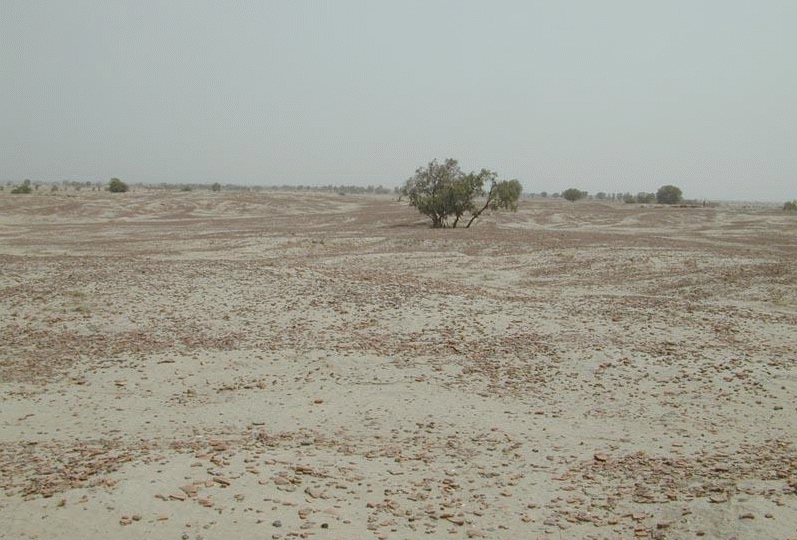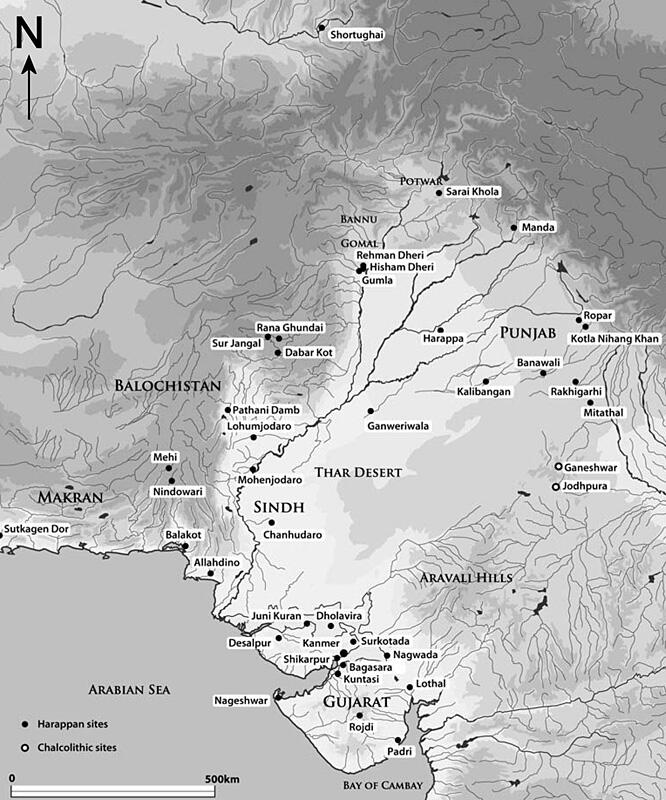By Nadine Zubair December 10th, 2016
Rehman Dheri is one of the earliest planned urban sites found in South Asia to date. The site was first explored in 1971 by Professor Ahmad Hassan Dani and excavated by Professor Farzand Ali Durrani from the University of Peshawar from 1976 to 1982, and again in 1991. Dr Abdul Samad (Peshawar Museum) and Dr Zakirullah Jan (University of Peshawar) have re-started excavations there in March 2015 to dig deeper into the archaeology of the site dating back to pre-Indus Valley Civilisation.
Rehman Dheri is a vast, low rectangular mound [Image 2] measuring 500 by 325 metres, situated 20 km NW of the town of Dera Ismail Khan in the Gomal Valley of Pakistan [Image 4]. It is densely strewn with the remnants of its final occupational phase including evidence of craft activities such as ceramics, slag, and a wide variety of semi-precious stones in different stages of manufacture. It consists of a large walled rectangular area with a grid network of streets and lanes dividing the settlement into regular blocks. The archaeological sequence at the site of Rehman Dheri is over 4.5 metres deep, and covers a sequence of over 1,400 years beginning at c.3300 BCE. The site represents following periods:
Phase I: ca. 3300-2850 BCE
Phase II: ca. 2850-2500 BCE
Phase III: ca. 2500-1900 BCE
It is generally accept that the settlement received its formal plan in its earliest phases and that subsequent phases replicated the plan over time. It began before the Kot Diji complex, and was abandoned at the beginning of the mature Indus phase by the middle of the third millennium BC and thus, subsequent activities, in a greatly reduced form, are only recorded on the neighbouring archaeological mound of Hisam Dheri. Since there was no occupation above the Kot Dijian phase, this Early Harappan settlement represents the most exceptionally preserved example of the beginning of urbanisation in South Asia.
Rehman Dheri is important because it shows continuity from early occupation through to the Kot Dijian/Early Harappan period, and the excavations show that the town wall and street layout were in place from the earliest occupation (ca. 3300 BCE). This continuity is also reflected in the material culture such as the pottery, where early levels illustrate a local style of pottery which later gives way to Kot Dijian motifs such as the bull and other geometric patterns. The preponderance of slag and vitrified brick along the western wall offer the possibility of specialised production regions within the site. Even though there is no direct evidence of writing at Rehman Dheri, graffiti marks on over 300 recorded pot shards may be precursors to the script.
"At Rehman Dheri," writes Mark Kenoyer, "a large walled settlement in the Gomal plain, seals have been found made from ivory [Image 1, showing two scorpions] as well as from fired steatite and shell. Some square steatite seals from Rehman Dheri and Harappa have a small knob on the back that is perforated for hanging on a string. This type of fired steatite seal became common in the later Indus cities as an important indicator of status and power."
Other items recorded include wheat and barley [Image 3] that were linked to clay storage containers inside houses, and the bones of cattle, sheep, goat and fish. Beads made from lapis lazuli and turquoise are “prestige goods” and indicative of long-distance contact. Terracotta figurines show changes from resembling the Gumla and Mehrgarh IV forms to becoming distinctively ‘Rehman Dheri’ in style. One seal is also recorded by Durrani. This was made from bone and has a scorpions engraved on one side and a figure with two goats on the other.
This site adds to our understanding of the complex social and regional development of the Indus Valley Civilization. Let us see what new analysis and explorations will reveal from this amazing site in the Gomal Valley!
Sources:
Durrani, F., Ali, I., & Erdosy, G. (1995). New Perspectives on Indus Urbanism from Rehman Dheri. East and West, 45(1/4), 81-96.
Coningham, R., & Young, R. (2015). The Archaeology of South Asia: From the Indus to Asoka, c. 6500 BCE-200 CE.New York, NY : Cambridge University Press.
Kenoyer, Jonathan M. (1998). Ancient cities of the Indus valley civilization. Oxford University Press; American Institute of Pakistan Studies.
1. Corpus of Indus Seals and Inscriptions, Vol. 2, Collections in Pakistan
2. Photograph: Rehman Dheri site
3. Grains: Archaeologists dig deeper into the history of Rehman Dheri
4. Map: Redefining the Harappan hinterland








